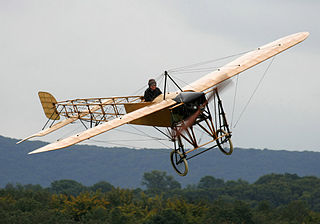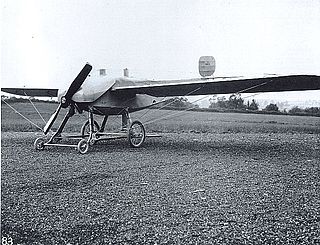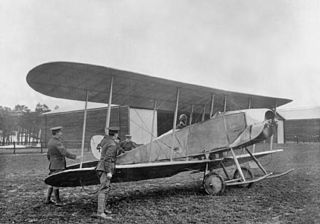Related Research Articles

Brooklands was a 2.75-mile (4.43 km) motor racing circuit and aerodrome built near Weybridge in Surrey, England, United Kingdom. It opened in 1907 and was the world's first purpose-built 'banked' motor racing circuit as well as one of Britain's first airfields, which also became Britain's largest aircraft manufacturing centre by 1918, producing military aircraft such as the Wellington and civil airliners like the Viscount and VC-10.

The Vickers Vimy was a British heavy bomber aircraft developed and manufactured by Vickers Limited. Developed during the latter stages of the First World War to equip the Royal Flying Corps (RFC), the Vimy was designed by Reginald Kirshaw "Rex" Pierson, Vickers' chief designer.

Those Magnificent Men in their Flying Machines; Or, How I Flew from London to Paris in 25 Hours and 11 Minutes is a 1965 period epic comedy film featuring an international ensemble cast including Stuart Whitman, Sarah Miles, Robert Morley, Terry-Thomas, James Fox, Red Skelton, Benny Hill, Jean-Pierre Cassel, Gert Fröbe and Alberto Sordi. The film, revolving around the craze of early aviation, was directed and co-written by Ken Annakin, with a musical score by Ron Goodwin.

The Avro 504 was a First World War biplane aircraft made by the Avro aircraft company and under licence by others. Production during the war totalled 8,970 and continued for almost 20 years, making it the most-produced aircraft of any kind that served in any military capacity during the First World War. More than 10,000 were built from 1913 until production ended in 1932.

The Vickers F.B.5 was a British two-seat pusher military biplane of the First World War. Armed with a single .303 in (7.7 mm) Lewis gun operated by the observer in the front of the nacelle, it was the first aircraft purpose-built for air-to-air combat to see service, making it the world's first operational fighter aircraft.

The Boxkite was the first aircraft produced by the British and Colonial Aeroplane Company. A pusher biplane based on the successful Farman III, it was one of the first aircraft types to be built in quantity. As the type was used by Bristol for instruction purposes at their flying schools at Larkhill and Brooklands many early British aviators learned to fly in a Boxkite. Four were purchased in 1911 by the War Office and examples were sold to Russia and Australia. It continued to be used for training purposes until after the outbreak of the First World War.

The Blériot XI is a French aircraft of the pioneer era of aviation. The first example was used by Louis Blériot to make the first flight across the English Channel in a heavier-than-air aircraft, on 25 July 1909. This is one of the most famous accomplishments of the pioneer era of aviation, and not only won Blériot a lasting place in history but also assured the future of his aircraft manufacturing business. The event caused a major reappraisal of the importance of aviation; the English newspaper The Daily Express led its story of the flight with the headline "Britain is no longer an Island".
The Bristol Biplane Type 'T', sometimes called the Challenger-Dickson Biplane, was a derivative of the Bristol Boxkite. It was built in 1911 by the British and Colonial Aeroplane Company and was designed as a cross-country racing aircraft for Maurice Tabuteau.

Hilda Beatrice Hewlett was an early aviator and aviation entrepreneur. She was the first British woman to earn a pilot's licence. She founded and ran two related businesses: the first flying school in the United Kingdom, and a successful aircraft manufacturing business which produced more than 800 aeroplanes and employed up to 700 people. She later emigrated to New Zealand.

The Royal Aircraft Factory F.E.1 was designed and built in 1910 by the pioneer designer Geoffrey de Havilland. He used it to teach himself to fly during late 1910. After De Havilland was appointed assistant designer and test pilot at the Army Balloon Factory at Farnborough in December 1910 the War Office bought the aircraft for £400. the aircraft was given the designation F.E.1

The Bristol Coanda Monoplanes were a series of monoplane trainers designed by the Romanian designer Henri Coandă for the British company British and Colonial Aeroplane Company.
Hewlett & Blondeau was a manufacturer of aeroplanes and other equipment based in Leagrave, Luton, England which produced more than 800 aeroplanes and employed up to 700 people.
Gustav Jules Eugene Blondeau was an early pilot and went on to form Hewlett & Blondeau Limited, an aircraft manufacturer in the United Kingdom. He was born on 8 March 1871 in Tergnier, France, and graduated from Farman Aircraft at Mourmelon in France on 10 July 1910, then joining the Gnome engine works. He later opened his own flying school at Brooklands, Surrey, where he met Hilda Hewlett.

The Farman III, also known as the Henry Farman 1909 biplane, was an early French aircraft designed and built by Henry Farman in 1909. Its design was widely imitated, so much so that aircraft of similar layout were generally referred to as being of the "Farman" type.

The Gnome 7 Lambda was a French designed, seven-cylinder, air-cooled rotary aero engine that was produced under license in Britain and Germany. Powering several World War I-era aircraft types it was claimed to produce 80 horsepower (60 kW) from its capacity of 12 litres although recorded figures are lower.

The Vickers R.E.P. Type Monoplanes were a series of single-engined monoplane aircraft built by Vickers prior to the outbreak of the First World War. They were developed from a French design for which Vickers had purchased a license, with eight being built.

Richard Harold Barnwell was an English aviation pioneer, who began as an aircraft builder. He died while flying an early Vickers fighter plane, as a test pilot.

The Royal Aircraft Factory B.E.3 was a single-engined rotary engined biplane developed by the British Royal Aircraft Factory prior to the First World War. The B.E.4 and B.E.7 were virtually identical aircraft that differed only in the engine fitted.
The Bristol P.B.8, or Bristol-Coanda P.B.8', was an early British-built, Romanian-designed two-seat biplane trainer made by the Bristol Aeroplane Company in 1914. Only one was completed, which was never flown.

The 1910 Deperdussin monoplane, is a general term for a variety of Deperdussin aircraft models built between 1910 and 1911. Initially released in August 1910, it was the first aircraft to be built in significant quantities by Aéroplanes Deperdussin. Many variations of the aircraft were produced, differing in size, engine type and horsepower and tail configuration. These were loosely labelled as the "Deperdussin monoplane", but were sometimes more specifically classified either by function or by seating-type. A number of Deperdussin monoplanes were flown successfully in air races and gained several speed and endurance records during 1911–1912. Several have survived, including an airworthy example in the Shuttleworth Collection in England.
References
- ↑ Vickers Aircraft since 1908 London: Putnam
- ↑ "Vickers Boxkite and EFB1". BAE Systems | International. Retrieved 2021-11-23.
- ↑ "Vickers Boxkite and EFB1". BAE Systems | United Kingdom. Retrieved 2021-11-23.